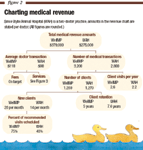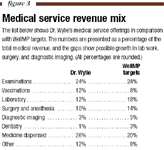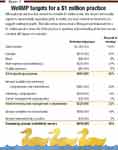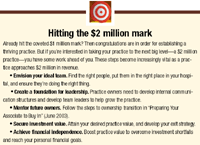Ducks in a row? Hitting the $1 million mark
Not long ago in a Midwestern town, the owner of Wylie Animal Hospital, a two-doctor practice, called our office for help. The caller, Dr. Rudy Wylie (a composite character based on real practitioners), was an established practitioner whose companion animal practice had always been able to pay its bills, give staff members an annual raise, and maintain its client base.
Not long ago in a Midwestern town, the owner of Wylie Animal Hospital, a two-doctor practice, called our office for help. The caller, Dr. Rudy Wylie (a composite character based on real practitioners), was an established practitioner whose companion animal practice had always been able to pay its bills, give staff members an annual raise, and maintain its client base.

figure 1 Wylie Animal Hospital Management Statement summary
As he recounted these successes, we wondered what exactly he needed help with. He lamented, "Well, that's just it, I'm stuck. We generate about $700,000 per year, but I want to move to the next level. I want to go from being a good $700,000 practice to being a great $1 million practice. I don't want to just maintain the status quo. I want to expand my facility, offer more to my staff, and enhance my medical technology. What should I do?" And so began our relationship with Dr. Wylie and his journey to the $1 million mark.
The qualities for success
What are the characteristics of a $1 million practice, aside from the obvious increased revenue and higher practice value? The basis for a $1 million practice begins with being a Well-Managed Practice (WellMP). In a WellMP, the owners enjoy practicing veterinary medicine and the patients' care always comes first. Beyond that, the practice runs more efficiently with a well-trained staff, and doctors and team members enjoy higher-than-average compensation. Leadership is always visible, and doctors and staff members show mutual respect. A WellMP also devotes more resources to sprucing up facilities and purchasing medical equipment.
In the $1 million practice, the foundational framework is financial management. Effective financial management must be in place to fund further expansion in areas such as employee and client development. And the bigger a practice gets, the more people you'll employ and the more structure you'll need to maintain the practice's integrity. Well-defined operating systems become mandatory. With this in mind, we set Dr. Wylie on a four-step path to achieve his goal of becoming a great $1 million practice.

figure 2 Charting medical revenue
Step 1: Clarify your vision
When you don't know what you're aiming for, you can spend a lot of time wavering on the path to your goal. A clear purpose and intention must guide your decision-making. Think back to when you first graduated veterinary school—or first entered school, for that matter.
Where did you want your career to take you? Would you be building a state-of-the-art, multi-doctor facility with the all of the latest medical technology? Would you practice in a mixed-animal practice as an associate? Would you specialize in surgery?
Dr. Wylie wants to practice medicine in such a way that "when clients want the best medical diagnosis and hope for a warm, welcoming medical staff, they come to our practice." To accomplish this goal, he needs top-notch technicians, friendly receptionists, and up-to-date medical technology. To offer an attractive pay range to top-caliber technicians and receptionists and to regularly invest in new equipment, Dr. Wylie knows his practice must be financially successful. His revenue must exceed his expenses, and he must have a plan for growth.

figure 3 Medical service revenue mix
Step 2: Establish effective documentation systems
Why is this important? What does it have to do with hitting the $1 million mark? Documentation helps to measure your progress toward your financial goals. Dr. Wylie already uses accounting software to track his expenses and a veterinary software package to track medical service revenue and client activity.
Dr. Wylie's next task: Start using a financial tool that lets an owner, practice manager, or accountant enter the information from the accounting and veterinary software into a consolidated, management format. This format will make it easier to monitor cash flow and generate the financial information necessary to make sound business decisions.
Cash flow is the lifeblood of veterinary practices and trying to use your income statement alone to guide decisions can leave you feeling frustrated because it includes some noncash items and ignores some cash outlays. A more inclusive approach is to use a Management Statement that looks at both items.

figure 4 Wylie Animal Hospitals reinvestment budget
The Management Statement developed by our firm helped Dr. Wylie view his revenue by service type and provider and identify key categories of expenses. (Figure 1, shows a summary of Dr. Wylie's Management Statement, which compares his performance with 2004 WellMP targets.) For the first six months, Dr. Wylie's practice manager submitted the Management Statement and the practice financial statements to our office, and we worked together to ensure all of the information was transferred correctly into the Statement. After that, the practice manager produced the Statement for Dr. Wylie's use.
Step 3: Establish a plan for revenue growth
To grow revenue, identify opportunities for improvement within key revenue components, including fee structure, average doctor transaction, number of doctor transactions, service and product mixes, service type, accounts receivable, active clients, client retention, client visitation and compliance, new clients, and patient age distribution. We charted these components for Dr. Wylie's practice focusing on medical revenue.
The two doctors produce $550,000 of the $700,000 of total revenue with an average doctor transaction of $98 and 2,800 transactions per doctor. The relationship of Dr. Wylie's revenue components, including the 2004 WellMP targets, is illustrated in Figure 2 .

figure 5 WellMP targets for a $1 million practice
Dr. Wylie's fees are on target given the level of medical care he's providing. However, his service mix and number of new clients offer opportunities for growth. (Figure 3, shows the 2004 WellMP statistics for service types compared with Dr. Wylie's service mix.)
Dr. Wylie's practice provides a WellMP level of examinations but diagnostic imaging, laboratory, and dental transactions are well under what we expected to see for a practice of his size. Why? His generous heart goes out to clients when it comes to providing these services. He watches the bottom line for his clients, and, with this mindset, he and his associate don't always offer services to those who seemingly can't afford them.
After we reinforced Dr. Wylie's original commitment to be an advocate for the patient rather than the client, he confirmed, "Offering high-level medicine for every patient and charging for every service, regardless of my perception of the clients' pocketbook, is important in achieving my practice vision of offering the best medical diagnosis, paying my staff members well, and equipping our facility with the best medical technology."

Hitting the $2 million mark
Once Dr. Wylie increased his diagnostic and dental services, his average doctor charge was $118, much more in line with the WellMP target for his practice. (With an average doctor transaction of $118, practice revenue will grow by $112,000 if the number of doctor transactions remains unchanged.) The next goal: Increasing client visits and adding new clients, which will require a facility expansion.
Step 4: Manage expenses for growth
Divide your operating expenses into seven categories: variable, fixed, staff compensation, facility, associate veterinary compensation, owner veterinary compensation, and owner management compensation. Then, summarize the information to show the practice's efficiency ratios, the amount available for reinvestment, and the amount available to owners after you've paid all operating expenses and set aside reinvestment dollars. Use the WellMP targets as a guide to establish targets for your own practice, and then monitor the variances between your targets and actual expenses to determine areas that need further attention.
Dr. Wylie's practice expenses are higher than the 2004 WellMP targets primarily because of lower medical revenue. As diagnostic imaging, laboratory, and dental services increase, expense percentages will fall more in line with WellMP targets.
The low facility costs reflect the need to expand his facility. Adding exam rooms will allow doctors to see more clients. A larger reception area with one or two additional staff members at the front desk will allow receptionists time to give callers their full attention and help to build the client base.
WellMPs typically allocate about 3 percent of revenue for reinvestment, which includes equipment leases, loans, and purchases. Managing expenses doesn't necessarily mean tightening the belt. There's a balance: Spending budgets should be developed with growth in mind. Clients' perception of value can be correlated to the reinvestment in your practice. Clients think you'll treat their pet the way you treat your practice. So reinvestment is critical if you want to take your practice to the next level.
Keeping your practice modern while maintaining fiscal responsibility is often a challenging prospect. Dr. Wylie's reinvestment over the past few years was sporadic and sometimes negatively affected his cash flow. We recommended he allocate his reinvestment dollars in accordance with the 2003 WellMP Study guidelines: 1.9 percent of revenue for medical equipment and 1.4 percent of revenue on office technology. Based on $700,000 of revenue, this meant spending about $13,000 on medical equipment and approximately another $10,000 on computer upgrades and new office technology.
"But," Dr. Wylie asked, "shouldn't I spend the same percentages in relation to $1 million instead of $700,000 given that's my revenue goal? That means spending $19,000 on medical equipment and $14,000 on computer equipment. I know I have those funds available by looking at my Management Statement."
His point is a good one. To get to the $1 million mark, he must begin thinking like a $1 million practice owner. And reinvesting with his revenue target in mind will help him achieve his goals. (Figure 4 shows how Dr. Wylie decided to allocate his investment dollars.)
Dr. Wylie is well on his way to becoming a $1 million practice. As of December, 2004, Dr. Wylie has been closely following his prescribed financial plan for about six months. Admittedly, he's run into a few challenges along the way, but he keeps on going. The last time we spoke, Dr. Wylie asked about the requirements for becoming a $2 million practice.
Reaching your target
Hopefully, hitting the $1 million mark doesn't seem as daunting with a step-by-step plan to follow. In our experience, practice owners find the pieces of the puzzle come together nicely once they clarify their vision, establish effective documentation systems, establish a plan for revenue growth, and manage their expenses. With a clear plan, you can focus your energy and efforts where they're needed most. So if your vision is to practice top-of-the-line medicine surrounded by satisfied co-workers and a strong client base, consider aiming high, at least $1 million high.
Veterinary Economics Financial Editor Cynthia R. Wutchiett, CPA, is president of Wutchiett Tumblin and Associates in Columbus, Ohio. Jennette Rosier Lawson is a consultant with Wutchiett Tumblin and Associates. Please send questions or comments to ve@advanstar.com.